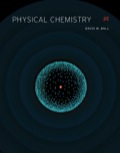
(a)
Interpretation:
The number of IR-active vibrations for
Concept introduction:
The complex vibrations exhibit by the polyatomic molecule is known as normal modes of vibrations. The vibrational modes of a molecule are IR or Raman active. If a molecule has centre of symmetry, then the modes which are IR-active will be Raman inactive and the modes that are IR-inactive will be Raman active. The total number of vibrational degrees of freedom for nonlinear molecule is represented by
(b)
Interpretation:
The number of IR-active vibrations for
Concept introduction:
The complex vibrations exhibit by the polyatomic molecule is known as normal modes of vibrations. The vibrational modes of a molecule are IR or Raman active. If a molecule has centre of symmetry, then the modes which are IR-active will be Raman inactive and the modes that are IR-inactive will be Raman active. The total number of vibrational degrees of freedom for nonlinear molecule is represented by
(c)
Interpretation:
The number of IR-active vibrations for
Concept introduction:
The complex vibrations exhibit by the polyatomic molecule is known as normal modes of vibrations. The vibrational modes of a molecule are IR or Raman active. If a molecule has centre of symmetry, then the modes which are IR-active will be Raman inactive and the modes that are IR-inactive will be Raman active. The total number of vibrational degrees of freedom for nonlinear molecule is represented by
(d)
Interpretation:
The number of IR-active vibrations for
Concept introduction:
The complex vibrations exhibit by the polyatomic molecule is known as normal modes of vibrations. The vibrational modes of a molecule are IR or Raman active. If a molecule has centre of symmetry, then the modes which are IR-active will be Raman inactive and the modes that are IR-inactive will be Raman active. The total number of vibrational degrees of freedom for nonlinear molecule is represented by
(e)
Interpretation:
The number of IR-active vibrations for
Concept introduction:
The complex vibrations exhibit by the polyatomic molecule is known as normal modes of vibrations. The vibrational modes of a molecule are IR or Raman active. If a molecule has centre of symmetry, then the modes which are IR-active will be Raman inactive and the modes that are IR-inactive will be Raman active. The total number of vibrational degrees of freedom for nonlinear molecule is represented by
Want to see the full answer?
Check out a sample textbook solution
Chapter 14 Solutions
EBK PHYSICAL CHEMISTRY
- (a) Identify the symmetry elements in ethene and in allene, and assign each molecule to a point group. (b) Consider the biphenyl molecule, Ph–Ph, in which different conformations are possible according to the value of the dihedral angle between the planes of the two benzene rings: if this angle is 0°, the molecule is planar, if it is 90°, the two rings are perpendicular to one another. For each of the following dihedral angles, identify the symmetry elements present and hence assign the point group: (i) 0°, (ii) 90°, (iii) 45°, (iv) 60°.arrow_forward(b) The lowest frequency rotational transition of ²H³³C1 occurs at 10.92 cm1. Determine (i) The rotational constant, B, in Hz (ii) The bond lengtharrow_forwardProve the following identities. (a) [t, p²] = 2ihp (b) [p, ²] = -2ihâarrow_forward
- I need the answer as soon as possiblearrow_forwardList all possible electronic transitions and describe why they are important and what instrument is used to identify these electronic transitions (i) CH4 (ii) CH3COCH3 (iii) CH3Br (iv) CH3COarrow_forwardHow many normal modes (different types of vibrational motion) are predicted for the following substances (a) Ar (b) CO (c) CO2 (d) NH3?arrow_forward
- How many normal vibrational modes does each of thefollowing molecules have?(a) NH3(b) C2H4(c) CCl2F2(d) CH3CH2OHarrow_forwardQ5. For CO2, the bending vibrations are of symmetry type, ay (a) A1g, +4² (Log (6) The Xc) Et (d) Azuarrow_forwardRotational spectra are affected slightly by the fact that different isotopes have different masses. Suppose a sample of the common isotope 1H35Cl is changed to 1H37Cl. (a) By what fraction is the molecule’s rotational inertia different? (The bond length is 0.127 nm in each case.) (b) What is the change in energy of theℓ = 1 to theℓ = 0 transition if the isotope is changed?arrow_forward
- (c) Determine the results of the following multiplications of symmetry operations for the anthracene molecule (chemical structure shown below, C2 represents the main axis). [5 (i) C2. Oh (ii) i C₂ (iii) E-ov O 500arrow_forwardConsider the rotational spectrum of a linear molecule at 298 K with a moment of inertia of 1.23×10−461.23\times10^{-46}1.23×10−46 kg m2 . (a) What is the frequency for the transition from J = 2 to J = 3? (b) What is the most populated rotational level for this molecule? Would the transition in (a) give the most intense signal in the rotational spectrum?arrow_forwardThe J = 0 to J = 1 rotational transition of the CO molecule occurs at a frequency of 1.15 x 1011 Hz.(A) Use this information to calculate the moment of inertia of the molecule. (B) Calculate the bond length of the molecule.arrow_forward
 Chemistry: The Molecular ScienceChemistryISBN:9781285199047Author:John W. Moore, Conrad L. StanitskiPublisher:Cengage Learning
Chemistry: The Molecular ScienceChemistryISBN:9781285199047Author:John W. Moore, Conrad L. StanitskiPublisher:Cengage Learning
